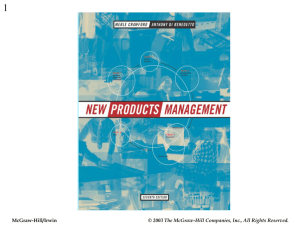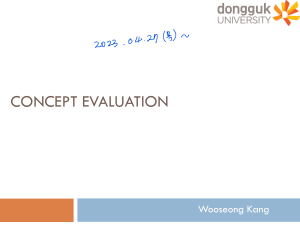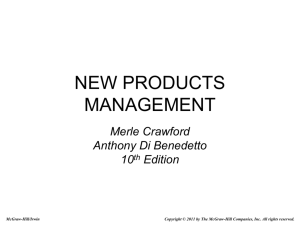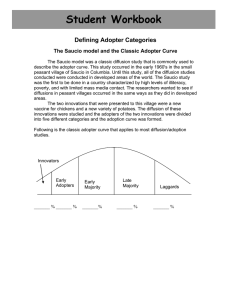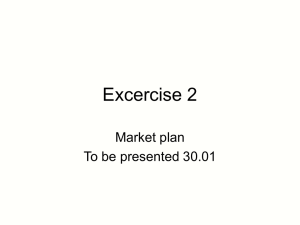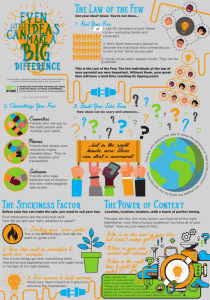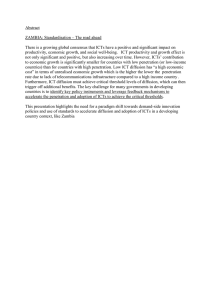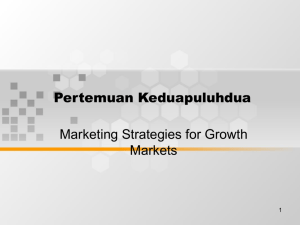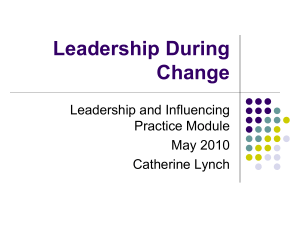Design Evaluation Demand Forecasting
advertisement
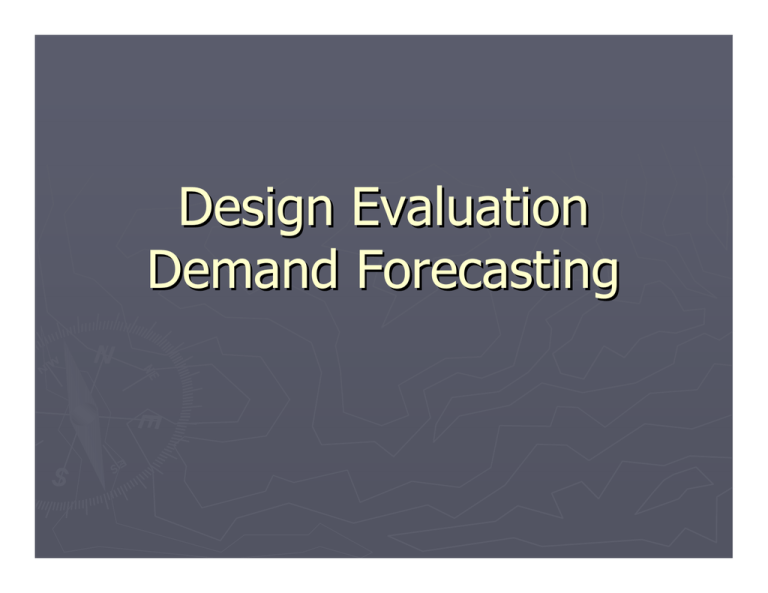
Design Evaluation Demand Forecasting “The art of prophecy is very difficult – especially with respect to the future.” Mark Twain 40% of New Products Fail ► No Basic Need for Product ► Overall ► Idea Product Does Not Meet Need Not Properly Communicated Number Of Ideas Mortality of New Product Ideas The Decay Curve Time What it takes ► A system or process to weed out projects ► An understanding of how innovations are embraced Innovators 2.5% µ-3σ µ-2σ µ-1σ Late Majority 34 % Early Adopters 13.5% Early Majority 34% Product Adoption Patterns µ µ+σ Laggards 16% µ+2σ Time Until Adoption µ+3σ Early Adopters ► Hi Education, Income, Status, Literacy ► Empathy, Less Dogmatic, Ability to Abstract, Rational, Intelligent, Able to Cope with Risk, Aspiration, Positive Attitude to Science, ► Social Participation, Media Exposure, Information ► No Relationship to Age Innovation vs. Imitation ► Innovators are not influenced by who already has bought ► Imitators become more likely to purchase with more previous buyers Probability of Purchase by New Adaptor in Period t Probability of Purchase without influence by adopter Kt p + q⋅ M Probability of Purchase through Influence by Adopter M = Market Size K t = Cumulative number of adopters before period t q = Effect of each Adopter on each Nonadopter (Coefficient of Internal Influence) p = Individual Conversion w/out influence by Adopters (Coefficient of External Influence) The Bass Model Imitation Effect or Internal Influence Kt Kt ⎛ Qt = p ⋅ (M − K t ) + q ⋅ ⋅ (M − K t ) = ⎜ p + q M M ⎝ Innovation Effect or External Influence Qt = Number of adopters during period t M = Market Size K t = Cumulative number of adopters before period t q = Effect of each Adopter on each Nonadopter (Coefficient of Internal Influence) p = Individual Conversion w/out influence by Adopters (Coefficient of External Influence) ⎞ ⎟ ⋅ (M − K t ) ⎠ Cumulative Sales for Different p,q Parameters Market Penetration 100% 80% 60% p = 0.5, q = 0.0001 p = 0.1, q = 0.1 p = 0.01, q = 0.25 40% 20% p = 0.001, q = 0.5 0% 1 6 11 16 Time 21 26 31 Cumulative Sales for Different p,q Parameters Market Penetration 50% 40% 30% 20% p = 0.5, q = 0.0001 p = 0.1, q = 0.1 p = 0.01, q = 0.25 p = 0.001, q = 0.5 10% 0% 1 6 11 16 Time 21 26 31 Diffusion Curve For Refrigerators 1926-1979 Market Penetration 100% 80% p = 0.025, q = 0.126 60% 40% 20% 0% 1926 1931 1936 1941 1946 1951 Time 1956 1961 1966 1971 1976 Diffusion Curve For Calculators 1973-1979 Market Penetration 100% 80% 60% 40% p = 0.143, q = 0.52 20% 0% 1973 1974 1975 1976 Time 1977 1978 1979 Diffusion Curve For Power Leaf Blowers, 1986-1996 100% Market Penetration 90% p = 0.013, q = 0.315 80% 70% 60% 50% 40% 30% 20% 10% 0% 1986 1991 1996 2001 Time 2006 2011 Diffusion Curve For Cell Phones 1986-1996 100% Market Penetration p = 0.008, q = 0.421 80% 60% 40% 20% 0% 1986 1991 1996 2001 Time 2006 2011 Example: Satellite Radio ► Roughly 160 million potential listeners ► Phone Survey (6,000) 96 million not willing to pay fee Interested, given costs [million] Subscription Price [$] Radio [$] 12 10 8 5 2 400 23.7 27.4 27.5 27.6 27.7 300 24.8 28.5 28.7 28.9 29.1 250 26.6 30.7 31.2 31.8 32.6 200 31.5 36.5 37.8 40.5 42.8 150 35.6 41.6 44.1 49.1 53.0 100 45.7 54.0 58.7 68.3 77.8 Source: E. Ofek, HBS 9-505-062, 2005 Analog Products Product p q Portable CD Player 0.0065 0.66 Auto Radio 0.0161 0.41 Cellular Phone 0.008 0.42 Source: E. Ofek, HBS 9-505-062, 2005 ► Factors For Assessing Analogies Product Characteristics Market Structure Buyer Behavior Marketing Mix Deriving M, p, & q from Data Kt K ⎞ ⎛ ⋅ (M − K t ) = ⎜ p + q t ⎟ ⋅ (M − K t ) M M ⎠ ⎝ = pM + (q − p ) ⋅ K t − Mq ⋅ K t2 Q t = p ⋅ (M − K t ) + q ⋅ = a + bK t − cK t2 p =a M q = − mc M = −b ± ► Compute a, b, and c with Ordinary Least Square Regression, given actual sales data b 2 − 4 ac 2c Commercial Software www.mktgeng.com www.basseconomics.com Limits of the Bass Model ► ► ► ► ► ► ► ► ► Static market potential Static geographic boundaries Independence of other innovations Simple “not adopt to adopt” framework Limitless supply No repeat or replacement sales Individual decision process neglected Deterministic Roger’s Five Factors ► Relative Advantage Product performance relative to incumbent ► Compatibility Consistency with existing values/experiences ► Complexity Ease of Use ► Triability Possibility to experiment with product ► Observability Visibility of usage and impact Example: Segway ► ► ► ► ► Relative Advantage Compatibility Complexity Triability Observability Example: Viagra ► ► ► ► ► Relative Advantage Compatibility Complexity Triability Observability A-T-A-R ► Awareness Who is aware of the product? ► Trial Who wants to try the product? ► Availability Who has access to the product? ► Repeat Who wants to try product again? The A-T-A-R Model ► Units Sold = * * * * * Market Potential Percentage aware Percent who try Percent who have access Percent who will repeat Number of repeats per year Sources for A-T-A-R Data Sources for Data A-T-A-R Data Basic Market Research Concept Test Product Use Test Market size Best Helpful Helpful Helpful Helpful Awareness* Trial Helpful Availability Helpful Repeat Helpful Best Component Testing Market Test Helpful Best Helpful Helpful Best Helpful * Often estimated by ad agency Best Helpful Source: M. Crawford & A. Di Benedetto, “New Products Management” , 2003 Concept Test (non tangible product) A-T-A-R Data Concept Test Market size Helpful Awareness* Helpful Trial Best Availability Repeat ► ► Weed out poor ideas Gauge Intention to purchase (Definitely (not), Probably (not), Perhaps) Respondents typically overstate their willingness to purchase Rule of thumb, multiply the percentage responding ► ► ► ► Definitely would purchase by 0.4 Probably would purchase by 0.2 Add up: The result is the % for trial Learning Conjoint Analysis Helpful Product Use Test (“tangible” product) A-T-A-R Data Product Use Test Market size Helpful Awareness* Helpful Trial Availability Repeat ► ► Use under normal operating conditions Learning ► Beta testing ► Pre-use reaction (shape, color, smell…) Ease of use, bugs, complexity Diagnosis Short term use tests with selected customers Does it wor? Gamma testing Long term tests (up to 10 years for med.) Best Market Test ► ► A-T-A-R Data Market Test Market size Helpful Awareness* Helpful Trial Helpful Availability Best Repeat Helpful Test product and marketing plan Test Marketing Limited Geographies (waning importance) ► ► Pseudo Sale, Controlled Sale, Full Sale Speculative Sale Full pitch with all conditions ► Simulated Test Market Stimuli, play money, pseudo store 300 – 600 Respondents, 2-3 months, $50k to $500k Additional Reading ► E. Rogers: “Diffusion of Innovations”, ► G. A. Moore: “Crossing the Chasm” ► 5th Edition, 2003 3rd Edition 2002 M. Crawford & A. Di Benedetto, “New Products Management” , 7th Edition, 2003 ► G. Lilien, P. Kotler, & K.S. Moorthy “Marketing Models” 1992, (fairly technical, limited availability) Tomorrow ► Industry Leaders in Technology and Management Lecture ► James Dyson Next Thursday Simon Pitts from Ford Motor Company ► Professional Behavior ► Please be on Time!!! ► No TAs on site
